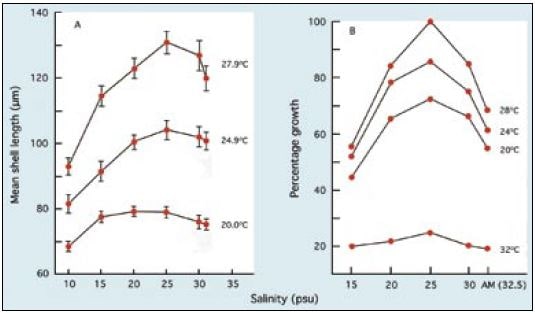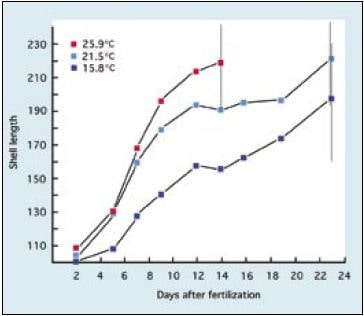5.3.2 Effects of temperature and salinity
Of all the factors that impinge on growth, development and survival of larvae in culture, temperature is one of the most important since metabolic rate is dictated by temperature of the water in which they swim.
Larvae of many of the commonly cultured bivalves exhibit a wide tolerance to both temperature and salinity, often well beyond conditions they may be exposed to in their natural environment. It should not be assumed when one is dealing with a species normally inhabiting cooler, offshore habitats, that larvae will necessarily show optimum performance within the temperature range to which the wild stock is exposed. Often, larvae grow best at higher temperatures than they would experience in nature. Similarly, tolerance limits of larvae to salinity is often much wider than might be anticipated. For example, calico scallop, Argopecten gibbus, larvae from stock adapted to an almost invariable salinity of 36 PSU in Bermuda are able to grow and develop to settlement at 20 PSU. Growth and development are slower, but survival to settlement is little different than in cultures raised at the higher salinity.
The growth of larvae of the Japanese scallop, Patinopecten yessoensis, larvae at various salinities and temperatures is shown in Figure 71. Tolerance exhibited to temperature by this species is quite typical of growth rates that apply to other cooler water scallop species including Placopecten magellanicus and Pecten maximus, which are normally cultured at 14 to 16oC. Growth, development and survival are adversely affected at higher temperatures. Offshore scallops such as Placopecten magellanicus and Pecten maximus have a higher salinity requirement (>30 PSU). In contrast, larvae of Argopecten species, e.g. the calico scallop (Argopecten gibbus) and the Bay scallop (Argopecten irradians concentricus) can be successfully cultured at temperatures as high as 26 to 28oC.
Oysters of the genus Crassostrea are extremely tolerant to both temperature and salinity in the culture environment. Interactions of these two factors on growth are shown in Figure 72. In both the Mangrove oyster, Crassostrea rhizophorae, and the Pacific oyster, Crassostrea gigas – and the same is true for the American oyster, Crassostrea virginica – growth, development and survival are near optimal at 28oC and at a salinity of 25 PSU. Larvae will also tolerate salinities as low as 10 PSU but survival suffers at 5 PSU. Survival exceeded 80% in all treatments over the duration of the trials with the two species.

Figure 71: Effects of temperature and salinity on the growth of larvae of the Japanese scallop, Patinopecten yessoensis. Larvae were grown at a salinity of 29 PSU in the temperature trial and at 15oC in the salinity trial. From Bourne et al. (1989)

Figure 72: The growth of A, Mangrove oyster, Crassostrea rhizophorae, in a 7-day period from D-stage (initial mean length 65 ?m) and B, Pacific oyster, Crassostrea gigas, larvae in a 10-day trial at various temperatures and salinities. Pacific oyster results are expressed as a percentage of the growth of larvae in the best treatment (28oC at 25 PSU). AM denotes ambient salinity which was 32.5 PSU in B.
Larvae of the European flat oyster, Ostrea edulis, are as tolerant to temperature as the Crassostrea species, but they are not as widely tolerant to lower salinities. While they will survive brief exposure to 20 PSU, growth and development rates in culture are near optimal at 28 to 32 PSU.

Figure 73: The growth of Manila clam, Tapes philippinarum, larvae from D-stage to metamorphosis at 3 temperatures. Vertical bars denote the range of larval shell lengths (?m) when pediveligers were first noted in cultures (A. Lovatelli, MSc thesis).
The growth of larvae of commercially cultivated, inshore and estuarine clams including the Manila clam, Tapes philippinarum, American hard shell clam, Mercenaria mercenaria, and the soft shell clam, Mya arenaria, also show tolerance to wide-ranging temperature and salinity conditions. Except for Mya arenaria, which is normally cultured at 18 to 20oC, larvae are generally grown at 25+2oC and at salinities ranging from 25 to 34 PSU. The effect of temperature on the growth of Manila clam larvae is shown in Figure 73.